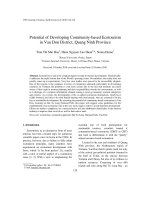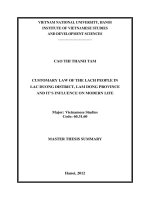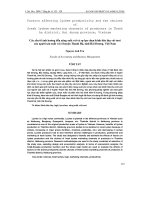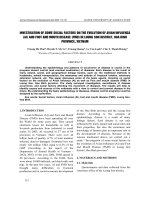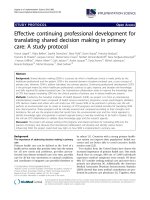Key factors influence the decision making in large sized timber plantation of local people in cam lo district quang tri province
Bạn đang xem bản rút gọn của tài liệu. Xem và tải ngay bản đầy đủ của tài liệu tại đây (549.33 KB, 56 trang )
VIETNAM NATIONAL UNIVERSITY OF FORESRY
FOREST RESOUCRES & ENVIRONMENTAL MANAGEMENT FACULTY
STUDENT THESIS
KEY FACTORS INFLUENCE THE DECISION MAKING IN LARGE-SIZED
TIMBER PLANTATION OF LOCAL PEOPLE IN CAM LO DISTRICT,
QUANG TRI PROVINCE
Majors: Natural Resources Management
Faculty: Forest Resources and Environmental Management
Student: Ngo Thi Mai
Student ID: 1453090563
Class: K59 Natural Resouces Management
Advanced Education Program
Developed in collaboration with Colorado State University, USA
Supervisor: Dr. Le Dinh Hai
Ha Noi, Oct 2018
TABLE OF CONTENTS
CHAPTER 1 ......................................................................................................................... 2
INTRODUCTION ............................................................................................................... 2
CHAPTER 2 ......................................................................................................................... 4
GOAL AND OBJECTIVES ................................................................................................ 4
2.1. Goal ....................................................................................................................... 4
2.2. Objectives ............................................................................................................. 4
2.3. Study Area ............................................................................................................. 4
2.4. Time Scale ............................................................................................................. 4
CHAPTER 3 ......................................................................................................................... 5
STUDY AREA AND RESEARCH METHODOLOGY................................................... 5
3.1. Study area ............................................................................................................. 5
3.1.1. Quang Tri Province .......................................................................................... 5
3.1.2. Cam Lo District ................................................................................................. 6
3.2. Definition of large-sized timber and small-sized timber..................................... 8
3.3: Research framework ............................................................................................ 9
3.4. Methodology ....................................................................................................... 10
3.4.1. Data collection method ................................................................................... 10
3.4.2. Data processing method ................................................................................. 12
3.4.3. Data analysis method ..................................................................................... 12
CHAPTER 4 ....................................................................................................................... 18
STUDY RESULTS AND DISCUSSION.......................................................................... 18
4.1: The situation about plantation forest in Cam Lo district ................................. 18
4.2. Descriptive statistic on survey households in Cam Lo district ....................... 18
4.2.1. Land area of households ................................................................................ 18
4.2.2: Education of household head ......................................................................... 20
4.2.3. Training for siviculture techniques .................................................................. 20
4.3. Key factors influence the decision making in large-sized timber forest
plantation of surveyed household ............................................................................ 21
4.3.1. Understanding markets about large-sized timber of local people .................... 23
4.3.2. FSC project participation of local people......................................................... 24
4.3.3. Support from community to encourage local people plant large-sized timber
forest ........................................................................................................................ 25
4.4. Compare cost-benifit between small-sized timber and large-sized timber ..... 26
i
CHAPTER 5 ....................................................................................................................... 28
SOLUTIONS AND LIMITATION .................................................................................. 28
5.1. Compare between large-sized timber plantation and small-size timber plantation . 28
5.2. Analyzing SWOT about planting large-sized timber forest..................................... 29
5.3. Solutions to encourage local people plant large-sized timber ................................ 29
5.4. Limitation ............................................................................................................ 31
CHAPTER 6: CONCLUSIONS ....................................................................................... 32
REFERENCES................................................................................................................... 33
APPENDIX ........................................................................................................................... 1
ii
LIST OF TABLE
Table 3.1: Survey Sampling design in Cam Lo District ..................................................... 11
Table 3.2: List of dependent variable and independent variable ........................................ 15
Table 4.1: Characteristic of surveyed household by commune in Cam Lo District ........... 19
Table 4.2: Key factors influence the decision making in large-sized timber plantation of
surveyed household ............................................................................................................. 22
iii
LIST OF FIGURE
Figure 3.1: The map of Quang Tri Province .......................................................................... 6
Figure 3.2: The map of Cam Lo district, Quang Tri Province............................................... 7
Figure 3.3: Research framework ............................................................................................ 9
Figure 3.4: Conceptual model for potential factors influencing decision making large-sized
timber plantation by local people......................................................................................... 10
Figure 3.5: Graph of Binary logistic regression .................................................................. 15
I choose 15 variable based on figure 3.4 Conceptual model for potential factors influencing
decision making large-sized timber plantation by local people ........................................... 15
Figure 4.1. Education level of household head in Cam Lo district ..................................... 20
Figure 4.2. Training for siviculture techniques of household .............................................. 21
Figure 4.3. Understanding markets about large-sized timber of local people ..................... 23
Figure 4.4: FSC project paticipation of local peope in Cam Lo district .............................. 25
Figure 4.5. Support from community for local people in Cam Lo district .......................... 26
iv
LIST OF ABBREVIATIONS
ADB
The Asian Development Bank
BCR
Benifit-cost ratio
BNN-TCLN Ministry of Agriculture- General Directorate of Forestry
(Bộ Nông Nghiệp- Tổng Cục Lâm Nghiệp )
EEPSEA
The Economy and Environment Program for Southeast Asia
FSC
Certificated for Sustainable Forest management
IRR
Internal rate of return
LWCC
Legacy of War Coordination Center
NPV
Net present value
ODA
Official Development Assistance
PAM
Programme Alimentaire Mondial
TCVN
Standard of Viet Nam (Tiêu Chuẩn Việt Nam)
VND
Việt Nam Đồng
v
ABSTRACT
At present, the forestry sector is very interested in planting large-sized timber.
Many models of planting large-sized timber are implementing and bring efficiency. The
purpose of this thesis is analyzing the key factors influence the decision making in largesized timber plantation of local people in Cam Lo district, Quang Tri province; the analyze
and evaluate cost-benefit of large-sized timber project. Collection data by questionnaire
and analyze data by SPSS software. The results show that three factors are influencing the
decision making in large-sized timber plantation of local people such as understanding
markets, FSC project participation, and support from the community. Profits from largesized timber plantation projects are higher than small-sized timber plantation. Therefore,
we will recommend some appropriate methods to encourage local people to plant largesized timber.
1
CHAPTER 1
INTRODUCTION
The roles and values of forests have been appreciated by people in history and
modern times. In the world, there are many countries and territories, the state and people
have a tradition of a plantation, especially in Europe and North America. Forests have
played a significant role in our lives to mitigating climate change. Forests help to regulate
the flow in rivers and surface ground. The water will be kept in the canopy when going
down the forest more than in the ground help the flow decrease in the storm season.
Forests prevent the surface flow when it runs too fast, making the floods appear more
slowly, reducing the level of sudden and severe. Water infiltrates the forest land as well as
the stock of plants and other organisms live in the soil. Therefore, the area has more forest
cover will reduce natural disasters, drought, and floods. The forest has control flow very
well. Vietnam has a large area of forest land, there are many policies, programs, and
projects for development and sustainable forest management. “Approving the action plan
to improve the productivity, quality, and value of forest plantation in the 2014-2020
period.” Issued together with Decision No. 774/QD-BNN-TCLN. Besides, “Approving
Viet Nam’s Forestry Development Strategy in the 2006-2020 period” issued together with
Decision No. 18/2007/QD-Ttg which was approved by the Prime Minister on February 5,
2017, an essential legal basis for the development of forestry in Vietnam.
In Vietnam, large-sized timber plantation understood harvest after 10-14 years. The
yields are 200 - 240m3/ha most of the trees reach the diameter of over 18cm, accounting
for 50% of the reserve of about 100-120m3/ha (Source: Mr. Nhu Van Ky-General Forestry
Department1). The majority of people choose hybrid acacia to convert from small-sized
1
Mr. Nhu Van Ky-General Forestry Department
2
timber plantation to large-sized timber plantation. In comparison with small-sized timber
plantation, the profit from large-sized timber is higher depending on the age of harvest and
the diameter of the tree
In March 2018, Quang Tri province has over 22,000 ha of large-sized timber that
was certificated from FSC for sustainable forest management (FSC), accounting for 40%
of the total forest area of certificated from FSC in the country. Large-sized timber has a
ten-year extraction cycle, as well as a choice of harvesting options, keep the forest cover to
minimize flooding. Quang Tri is the leading province in developing large-sized timber
from FSC, and it is approving to promote economic development, environment. Besides,
in Cam Lo district, Quang Tri province has been implemented the model of developing
large-sized timber plantation. Cam Lo has developed the model of hybrid acacia hybrid
13.5 years old. This is the model of the State level project in the period of 2001-2005, code
KC.06.05.NN, also in the study area "Research on the system of intensive acacia hybrid
plantation techniques, Acacia auriculiformis provide large timber on new land" from 2015
to 2019 by Nguyen Huy Son and Pham Xuan Dinh is the manager.
However, the forest owner usually makes decision harvest based on factors such as
environmental condition and profit of products. If making the decision, Is the forest owner
understand the economic benefits of shortening the plantation rotation? If plantation largesized timber for a long time, It would have benefit and potential for local people? What is
factor influence the decision making of local people to plant large-sized timber?
To explain these issues, developing large-sized timber plantation in a community is
an urgent choice. Therefore, I decided to do the research project "Key factors influence the
decision making in large-sized timber plantation of local people in Cam Lo District, Quang
Tri Province".
3
CHAPTER 2
GOAL AND OBJECTIVES
2.1. Goal
Analyzing the scientific and practical issues to develop large-sized timber forest in
Cam Lo district, Quang Tri province; providing information help local people understand
the efficiency of large-sized timber plantation to develop large-sized timber in Cam Lo
district, Quang Tri province.
2.2. Objectives
(1)
Analyzing the key factors influence the decision making of local people to largesized timber plantation
(2)
Proposing some solutions to encourage local people to develop large-sized timber
plantation in Cam Loc district, Quang Tri province.
2.3. Study Area
- Research project in Cam Lo district, Quang Tri province.
2.4. Time Scale
- Collecting secondary data for research from 2014-2019.
- Collecting primary data from 7/2018-8/2018.
4
CHAPTER 3
STUDY AREA AND RESEARCH METHODOLOGY
3.1. Study area
3.1.1. Quang Tri Province
Quang Tri is a province in the North Central Coast region of Vietnam, north of the
former imperial capital of Hue. Quang Tri is a province in the North Central Coast region
of Vietnam. Quang Tri has 10 sub-divisions such as Cam Lo, Con Co, Da Krong, Gio
Linh, Hai Dang, Huong Hoa, Trieu Phong, Vinh Linh; 1 district town is Quang Tri and 1
provincial city is Dong Ha Forest land with forest cover is 219,638.85 ha, accounting for
72.73% of the agricultural land area, production forest is 101.631,02 ha, protection forest is
62.664,45 ha, particular use forest 55.343,38 ha. Quang Tri located in a tropical monsoon
climate, high temperature, light and rain regime, abundant moisture, high altitude is the
fundamental advantages for the development of crops, forestry. However, Quang Tri
considered quite a harsh climate, influenced by strong southwest winds blowing from
March to September, the cause of drought. From October to February of the following
year, it affected by the northeast monsoon with rain, the cause of the flood. Annual average
temperature is 24-25°C in the lowland, 220-23°C at an altitude of 500m. Annual rainfall is
about 2,200-2,500 mm, the number of rainy days in the year ranges from 154 to 190 days,
focusing on September, October, and November.
Cam Lo District, Quang Tri Province chose to be a case study because of the
following reasons. Firstly, Cam Lo district located in the central area of Quang Tri
province has a natural area of 367.4 km2, accounting for 8% of the Quang Tri province.
Secondly, in this area planted 5 million hectares of new forest and some afforestation
projects such as large-sized timber plantation under certificated from FSC for sustainable
forest development. By the end of 2016, forest cover reach to 52%.
5
Figure 3.1: The map of Quang Tri Province
3.1.2. Cam Lo District
a. Geographic Location
Cam Lo district located in the central area of Quang Tri province, at 16041 ' 16053' north latitude, 106050' - 107006' east longitude. Border by Gio Linh to the North ;
Trieu Phong and Dakrong to the South; Dong Ha city by the East and Đakrông district on
the West, Cam Lo located on the intersection of critical traffic routes, that are National
highway 1A; Ho Chi Minh road; Highway 9 - inter-Asian routes linking Vietnam - Laos Thailand and other regional countrie
b. Topography
Cam Lo currently has 9 administrative including Cam Lo Townlet, Cam An, Cam
Thanh, Cam Thuy, Cam Hieu, Cam Chinh, Cam Nghia, Cam Tuyen, and Cam Thanh. The
average temperature is 24 - 25˚C, the lowest month is 18,9°C ( January, February), the
highest month is 30,3°C ( June, July), the temperature of day and night is 6.5 - 7˚C. The
average of rainfall in the area is very high about 2400 mm, accounting for 80% of rainfall
6
concentrated from September to December with high rainfall intensity. The frequency of
floods concentrated from September to November.
Figure 3.2: The map of Cam Lo district, Quang Tri Province
c. Soil and land use
Cam Lo terrain features shades of terrain transition from the Truong Son mountain
to the sea, terrain elevation from 50 to 400m with three distinct subregions. The lowland
area in the west-northwest consists of Cam Thanh and Cam Tuyen communes with sloping
topography to the east, with steep slopes, which are favorable for forest tree planting. The
mountain areas of Cam Chinh and Cam Nghia Communes are characterized by highland
sub-areas, which are favorable for planting long-term industrial trees. The delta along the
banks of the Hieu River in Cam An, Cam Thanh, Cam Thuy, Cam Hieu, and Cam Lo
communes is suitable for the development of short-term industrial crops and food crops.
Soils of Cam Lo are mainly red soil group accounting for 84% of the area; 69.7% of the
natural land area, a slope of less than 250; Natural soil with thick soil layer suitable for the
development of short-term plants and long-term industrial plants.
7
d. Socio-economic characteristic
The population of Cam Lo district is 45.433 people (23.161 women, accounting for
51% and 22.272 men, accounting for 49%). The average population density is 132 people /
km2. The population is concentrated in rural areas with 39,019 people, accounting for
86.1%, urban areas with 6,414 people, accounting for 13.9%. The labor is 28,087 people,
accounting for 61.7%. Annually, having 800-900 workers can be employed. However, the
quality of labor is still inadequate, most of the labor force is active in agriculture and
forestry, the number of laborers working in the industry and services is still low.
3.2. Definition of large-sized timber and small-sized timber
Large-sized timber and small-sized timber classified by many different purposes of
use and different in diameter or total height of tree species. Small-sized timber plantation
with the primary purpose of supplying small timber, wood chips. Large-sized timber
plantation with the aim of providing sawn timber with a large-sized timber yield of 70%.
Based on TVCN 11567-1:2016 “Plantation - Large timber plantation transformation from
small wood - Part 1: Acacia hybrid (A.mangium x A- auricculiformis)” classified
characteristic of large-sized timber and small-sized timber. Because the research object is
Acacia hybrid.
Small –sized timber
Large –sized timber
Rotation
<10 years
From 10 years
Diameter
< 15 cm
≥ 15cm (top diameter); length ≥2m
(Source: TVCN 11567-1:2016)
8
3.3: Research framework
Research framework is presented in Figure 3.3.
Study overview
Base on:
Compare large-sized timber with
small-sized timber:
-
-
Definition
Criteria
Compare
-
Decree
Decision
Policy
Documents
Method
Key factors influence to the
decision making of local people
-
Household survey
Questionaire
Solutions
Figure 3.3: Research framework
Conceptual model for potential factors influencing decision making large-sized
timber plantation by local people is presented in Figure 3.4. Some group factors can
influence to decision making of local people such as household characteristic, socioeconomic, policy and biophysical factor.
9
Household
characteristic
factor
(Age, Gender,
education level,
household size,
motivation and
skill)
Socio-economic
factor
(opportunity
cost of various
production,
input and output
price in the
market, Price
Policy factor
(land and tree
property right,
forest support
program,
information
for forest
owner)
Farms
characteristic
Biophysical
(natural
condition,
natural disater,
distance to
market)
(soil quality,
factor
Slope)
fluctuations)
Decision of large-sized timber plantation
Figure 3.4: Conceptual model for potential factors influencing decision making largesized timber plantation by local people
3.4. Methodology
3.4.1. Data collection method
Collecting secondary data:
Collect selected documents, synthesized from documents and research works
already published at the concerned agencies:
+ Indicators describing the location, characteristics of resources ... from the
statistical yearbook of the General Statistics Office, Statistical Office of the provinces,
District Statistics Office.
+ Indicators describing the status of plantation development (area, yield, plantation
structure...) from annual reports, Department of Planning and Investment, Department of
Natural Resources and Environment, Department of Finance Natural Resources and
Environment, Forestry... Using statistic report and professional survey reports, documents
and data from specialized publications and websites.
10
+ Referring to domestic and foreign documents, inherit and select the published
research results.
Collecting primary data:
- Three communes were chosen to conduct the survey, including Cam Chinh
Commune, Cam Nghia Commune, and Cam Thuy Commune. The main reason for
choosing 3 communes is that they have many households involving in forest plantation and
forest plantation under large-sized timber with forest sustainable certificate (FSC).
- Selection of sample: Random stratified sampling method was not repeated from
the list of participants in afforestation in each commune. The samples selected for the
survey were 150 households with 30 households in Cam Thuy commune, 43 household in
Cam Chinh commune and 57 households in Cam Nghia commune.
Table 3.1: Survey Sampling design in Cam Lo District
Survey household
Village
Commune
Planting small-
Planting large-
sized timber
sized timber
Total
Phuong An 1
23
11
12
Quat Xa
40
22
18
Cam Lo Phuong
10
5
5
Son Nam
24
12
12
Thanh Nam
23
21
2
Thien Chanh
30
9
21
150
80
70
Cam Chinh
Cam Nghia
Cam Thuy
Total
11
Through the questionnaire, interviews directly with the interviewees, questionnaires
were prepared at the study site.
+ Managers at all levels related to afforestation, large-sized timber plantation
projects.
+ Forest owner in Cam Lo district.
3.4.2. Data processing method
Data collected from the questionnaire will be aggregated using the Excel software
in Microsoft Office and the SPSS 23 software on the computer.
3.4.3. Data analysis method
Cost-benefit analysis (CBA)
Using NPV, BCR, IRR indicators for calculations and analysis to evaluate the
effectiveness of afforestation schemes at different ages.
-
Net Present Value (NPV): is used in capital bubgeting to analyze the profitability
of a projected or project.
+ Formular of NPV( Net Present Value):
Bi : Benifit of project in year i
In which: Ci : Cost of project in year i
r: Discount rate
n : The time of the project
NPV > 0: Efficiency Project
If:
NPV = 0: Break even
NPV < 0: Not efficiency Project
12
-
Benifit-Cost Ratio (BCR) is an indicator of the financial performance of the
project.
+ Formular of BCR
Bi : Benifit of project in year i
BCR =
In which: Ci : Cost of project in year i
=
r: Discount rate
n : The time of the project
NPV: Net present value
BCR > 1: Efficiency Project
If: BCR = 1: Break even
BCR < 1: Not efficiency Project
-
Internal Rate of Return (IRR) is a metric used in capital budgeting to
estimate the profitability of potential investments. Internal rate of return is a
discount rate that makes the net present value (NPV) of all cash flows from a
particular project equal to zero.
+ Formular of IRR
Bi : Benifit of project in year i
NPVIRR =
=0
In which: Ci : Cost of project in year i
IRR: Internal rate of Return
n : The time of the project
NPV: Net present value
IRR > r: Efficiency Project
If: IRR = r: Break even
IRR < r: Not efficiency Project
Assume that the one large-sized timber rotation are equal to two small-sized
timber rotation (5-years for small-sized timber, 10-year for large-sized timber).
13
Binary logistic regression method
Applying Binary Logistic Regression Model to accessing key divers affecting
decision making of small household in long- term rotation plantation practice. Since
minimum sample size is calculate by following formula (Tabachnick & Fidell,2007):
n > 50 + 8m
In which: n: sample size
m: number of independent variables
Binary logistic is a model that uses dependent variables as qualitative variables with
two option “Yes-No”,set up the regression model, process statistics on the SPSS software.
The Binary Logistic regression model uses a binary dependent variable to estimate
the probability that an event will occur with the information of the independent variable.
+ The dependent variable is the decision of the forest owner to large timber forest
plantation (Y dependent variable with two values 0 and 1, "0" - No large-sized timber
plantation, "1"- large-sized timber plantation)
+ Independent variables X1, X2,... Xk - Factors influence the decision making to
forest plantation of local people.
Based on this binary dependent variable, a procedure is used to predict the
probability of an event occurring according to the rule if the predicted probability is greater
than 0.5 (the default cutoff point). The predicted result will be " Yes "event occurs,
otherwise the predicted result will be" No ".
Binary logistic regression have model:
P = P(Yi=1) =
14
Figure 3.5: Graph of Binary logistic regression
(Soure: Nguyenngocbichphuong.com)
I choose 15 variable based on figure 3.4 Conceptual model for potential factors
influencing decision making large-sized timber plantation by local people
Table 3.2: List of dependent variable and independent variable
No.
Variable
Descreption
Note
Dependent variable
1
Decision
Decision of local people on 1=Yes
planting large- sized timber
0=No
Gender of household head
Female
Independent variable
2
Gender
Male
3
Age
Age of household head
4
Education level
The education level of household 1=Primary school
head
2=Secondary school
3=High School
15
5
Labor
Total member of household
Member pratice plantation
6
Type of household
Raking of household
1=Poor
2=Medium
3=Rich
7
Income and Capital
Income per month of household
Income from forest (1ha)
Total money invest in 1ha
8
Silvicultural
Training session for sivilculture 1=Yes
techniques and skills
skills
9
Land area
Total land area and forest land
10
Distance to the field
Distance frome household to the
0=No
field
11
Accessibility to the
1=Easy
fileld
2=Moderate
3=Difficult
12
Using fertilizer
Using fertilizer when plantation 1=Yes
forest
13
FSC
0=No
project
1=Yes
participaion
14
Support
0=No
from Support from local community 1=Yes
community
for large-sized timber plantation 0=No
activities of household.
15
Understand market
Understanding of local people to 1=Yes
large-sized timber market
16
0=No
Analyze SWOT method
A method to analyze the strengths, weaknesses, opportunities and challenges in
large-sized timber development in Quang Tri province. Based on that, appropriate
measures are put in place to develop large-sized timber in the province.
17
CHAPTER 4
STUDY RESULTS AND DISCUSSION
4.1: The situation about plantation forest in Cam Lo district
Planting forest area is the project programs such as 327, PAM, ADB, VietGermany, 661, FSC and plantation forest with own capital of company and households.
Planting forest of programs and projects usually arrange between the chief crops native
trees and acacia trees, density about 1650 trees/ha with ratio 1:1. The area forest plantation
with own capital is Acacia species, density from 1650 to 2000 trees/ha with ratio 1:1. At
present, the district has 16,670.7 ha of plantation forest with protection forest area is
1,858.8 ha and production forest area is 14,811.9 ha. After surveying, the situation of forest
plantation in Cam Lo district mainly involves in small-sized timber plantation with rotation
about 5 to 7 years.
4.2. Descriptive statistic on survey households in Cam Lo district
4.2.1. Land area of households
In overall, mean of total land area per each household is quite hight (over 5ha).
Most of the households in the village plantation forest with the minimum area of forest
about 0,4 ha and the maximum area are 23 ha. In Cam Thuy, forest area accounting for
40% of the total land area. In Cam Nghia, accounting for 60% and Cam Chinh is 71% of
the total land area.
18
Table 4.1: Characteristic of surveyed household by commune in Cam Lo District
Decision
Age
N
Mean
Std.
Std. Error
Deviation
Mean
Yes
70
51.13
9.236
1.104
No
80
52.49
11.713
1.310
Yes
70
3.74
1.315
.157
No
80
3.70
1.216
.136
Member pratice
Yes
70
2.00
.538
.064
plantation
No
80
1.98
.224
.025
Income
Yes
70
12.76
6.049
.723
No
80
12.58
6.148
.687
Yes
70
11.26
3.087
.369
No
80
11.26
3.306
.370
Yes
70
56.57
16.006
1.913
No
80
54.69
9.152
1.023
Yes
70
5.371
4.0683
.4863
No
80
3.378
2.0685
.2313
Yes
70
4.356
3.7011
.4424
No
80
2.700
1.9201
.2147
Yes
70
3321.43
1479.414
176.824
No
80
3175.00
1565.248
175.000
Total member
Invest in 1ha
Revenue
Total land area (ha)
Forest land area (ha)
Distance to the field
The table is group statstic of survey household, it is some factors collected when
surveying each household.
19


